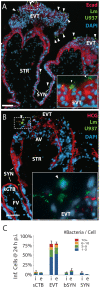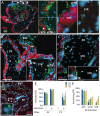Placental syncytiotrophoblast constitutes a major barrier to vertical transmission of Listeria monocytogenes
- PMID: 20107601
- PMCID: PMC2809766
- DOI: 10.1371/journal.ppat.1000732
Placental syncytiotrophoblast constitutes a major barrier to vertical transmission of Listeria monocytogenes
Abstract
Listeria monocytogenes is an important cause of maternal-fetal infections and serves as a model organism to study these important but poorly understood events. L. monocytogenes can infect non-phagocytic cells by two means: direct invasion and cell-to-cell spread. The relative contribution of each method to placental infection is controversial, as is the anatomical site of invasion. Here, we report for the first time the use of first trimester placental organ cultures to quantitatively analyze L. monocytogenes infection of the human placenta. Contrary to previous reports, we found that the syncytiotrophoblast, which constitutes most of the placental surface and is bathed in maternal blood, was highly resistant to L. monocytogenes infection by either internalin-mediated invasion or cell-to-cell spread. Instead, extravillous cytotrophoblasts-which anchor the placenta in the decidua (uterine lining) and abundantly express E-cadherin-served as the primary portal of entry for L. monocytogenes from both extracellular and intracellular compartments. Subsequent bacterial dissemination to the villous stroma, where fetal capillaries are found, was hampered by further cellular and histological barriers. Our study suggests the placenta has evolved multiple mechanisms to resist pathogen infection, especially from maternal blood. These findings provide a novel explanation why almost all placental pathogens have intracellular life cycles: they may need maternal cells to reach the decidua and infect the placenta.
Conflict of interest statement
The authors have declared that no competing interests exist.
Figures








Similar articles
-
Listeriosis in the pregnant guinea pig: a model of vertical transmission.Infect Immun. 2004 Jan;72(1):489-97. doi: 10.1128/IAI.72.1.489-497.2004. Infect Immun. 2004. PMID: 14688130 Free PMC article.
-
Targeting and crossing of the human maternofetal barrier by Listeria monocytogenes: role of internalin interaction with trophoblast E-cadherin.Proc Natl Acad Sci U S A. 2004 Apr 20;101(16):6152-7. doi: 10.1073/pnas.0401434101. Epub 2004 Apr 8. Proc Natl Acad Sci U S A. 2004. PMID: 15073336 Free PMC article.
-
Invasive extravillous trophoblasts restrict intracellular growth and spread of Listeria monocytogenes.PLoS Pathog. 2011 Mar;7(3):e1002005. doi: 10.1371/journal.ppat.1002005. Epub 2011 Mar 3. PLoS Pathog. 2011. PMID: 21408203 Free PMC article.
-
Understanding how Listeria monocytogenes targets and crosses host barriers.Clin Microbiol Infect. 2005 Jun;11(6):430-6. doi: 10.1111/j.1469-0691.2005.01146.x. Clin Microbiol Infect. 2005. PMID: 15882192 Review.
-
Maternal-neonatal listeriosis.Virulence. 2020 Dec;11(1):391-397. doi: 10.1080/21505594.2020.1759287. Virulence. 2020. PMID: 32363991 Free PMC article. Review.
Cited by
-
Human Listeriosis.Clin Microbiol Rev. 2023 Mar 23;36(1):e0006019. doi: 10.1128/cmr.00060-19. Epub 2022 Dec 8. Clin Microbiol Rev. 2023. PMID: 36475874 Free PMC article. Review.
-
Murine fetoplacental infection models.Infect Immun. 2010 Nov;78(11):4965; author reply 4965-6. doi: 10.1128/IAI.00641-10. Infect Immun. 2010. PMID: 20956576 Free PMC article. No abstract available.
-
The matter of the reproductive microbiome.Obstet Med. 2019 Sep;12(3):107-115. doi: 10.1177/1753495X18775899. Epub 2018 May 17. Obstet Med. 2019. PMID: 31523266 Free PMC article. Review.
-
Tissue barriers of the human placenta to infection with Toxoplasma gondii.Infect Immun. 2012 Jan;80(1):418-28. doi: 10.1128/IAI.05899-11. Epub 2011 Nov 14. Infect Immun. 2012. PMID: 22083708 Free PMC article.
-
Hofbauer Cells Spread Listeria monocytogenes among Placental Cells and Undergo Pro-Inflammatory Reprogramming while Retaining Production of Tolerogenic Factors.mBio. 2021 Aug 31;12(4):e0184921. doi: 10.1128/mBio.01849-21. Epub 2021 Aug 17. mBio. 2021. PMID: 34399615 Free PMC article.
References
-
- Moffett A, Loke C. Immunology of placentation in eutherian mammals. Nat Rev Immunol. 2006;6:584–594. - PubMed
-
- Trowsdale J, Betz AG. Mother's little helpers: mechanisms of maternal-fetal tolerance. Nat Immunol. 2006;7:241–246. - PubMed
-
- Medawar PB. 1953. pp. 320–338. Some immunological and endocrinological problems raised by the evolution of viviparity in vertebrates.
-
- Drevets DA, Bronze MS. Listeria monocytogenes: epidemiology, human disease, and mechanisms of brain invasion. FEMS Immunol Med Microbiol 2008 - PubMed
-
- Swaminathan B, Gerner-Smidt P. The epidemiology of human listeriosis. Microbes Infect. 2007;9:1236–1243. - PubMed
Publication types
MeSH terms
Grants and funding
LinkOut - more resources
Full Text Sources
Other Literature Sources
Medical

